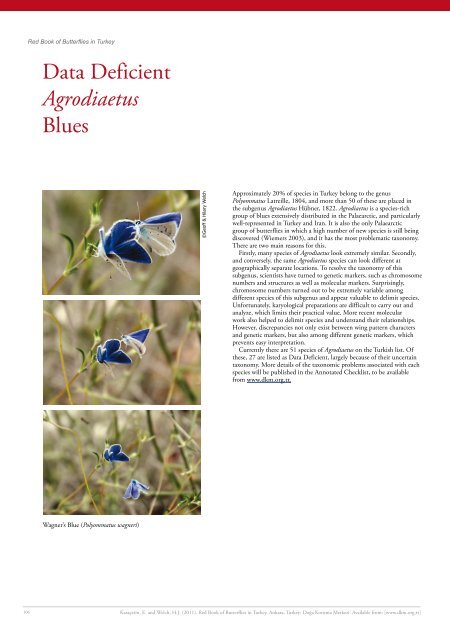Red Book of Butterflies in Turkey Red Book of Butterflies in Turkey
Red Book of Butterflies in Turkey Red Book of Butterflies in Turkey
Red Book of Butterflies in Turkey Red Book of Butterflies in Turkey
You also want an ePaper? Increase the reach of your titles
YUMPU automatically turns print PDFs into web optimized ePapers that Google loves.
106<br />
<strong>Red</strong> <strong>Book</strong> <strong>of</strong> <strong>Butterflies</strong> <strong>in</strong> <strong>Turkey</strong><br />
Data Deficient<br />
Agrodiaetus<br />
Blues<br />
Wagner’s Blue (Polyommatus wagneri)<br />
©Ge<strong>of</strong>f & Hilary Welch<br />
Approximately 20% <strong>of</strong> species <strong>in</strong> <strong>Turkey</strong> belong to the genus<br />
Polyommatus Latreille, 1804, and more than 50 <strong>of</strong> these are placed <strong>in</strong><br />
the subgenus Agrodiaetus Hübner, 1822. Agrodiaetus is a species-rich<br />
group <strong>of</strong> blues extensively distributed <strong>in</strong> the Palaearctic, and particularly<br />
well-represented <strong>in</strong> <strong>Turkey</strong> and Iran. It is also the only Palaearctic<br />
group <strong>of</strong> butterflies <strong>in</strong> which a high number <strong>of</strong> new species is still be<strong>in</strong>g<br />
discovered (Wiemers 2003), and it has the most problematic taxonomy.<br />
There are two ma<strong>in</strong> reasons for this.<br />
Firstly, many species <strong>of</strong> Agrodiaetus look extremely similar. Secondly,<br />
and conversely, the same Agrodiaetus species can look different at<br />
geographically separate locations. To resolve the taxonomy <strong>of</strong> this<br />
subgenus, scientists have turned to genetic markers, such as chromosome<br />
numbers and structures as well as molecular markers. Surpris<strong>in</strong>gly,<br />
chromosome numbers turned out to be extremely variable among<br />
different species <strong>of</strong> this subgenus and appear valuable to delimit species.<br />
Unfortunately, karyological preparations are difficult to carry out and<br />
analyze, which limits their practical value. More recent molecular<br />
work also helped to delimit species and understand their relationships.<br />
However, discrepancies not only exist between w<strong>in</strong>g pattern characters<br />
and genetic markers, but also among different genetic markers, which<br />
prevents easy <strong>in</strong>terpretation.<br />
Currently there are 51 species <strong>of</strong> Agrodiaetus on the Turkish list. Of<br />
these, 27 are listed as Data Deficient, largely because <strong>of</strong> their uncerta<strong>in</strong><br />
taxonomy. More details <strong>of</strong> the taxonomic problems associated with each<br />
species will be published <strong>in</strong> the Annotated Checklist, to be available<br />
from www.dkm.org.tr.<br />
Karaçet<strong>in</strong>, E. and Welch, H.J. (2011). <strong>Red</strong> <strong>Book</strong> <strong>of</strong> <strong>Butterflies</strong> <strong>in</strong> <strong>Turkey</strong>. Ankara, <strong>Turkey</strong>: Doğa Koruma Merkezi. Available from: [www.dkm.org.tr]


